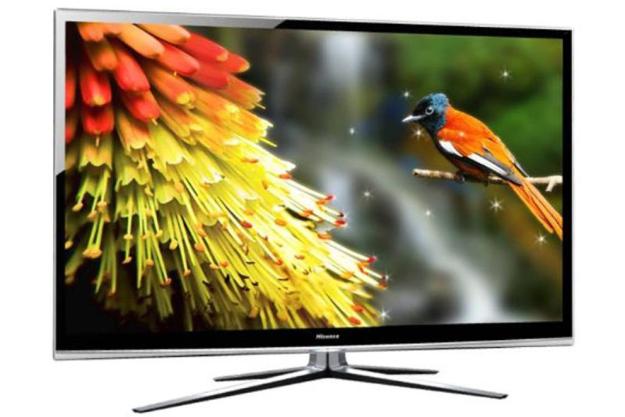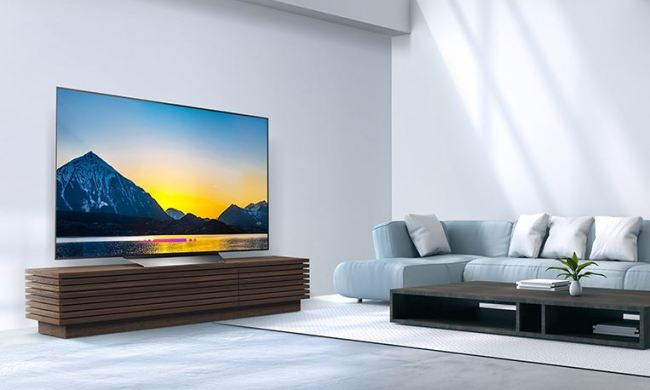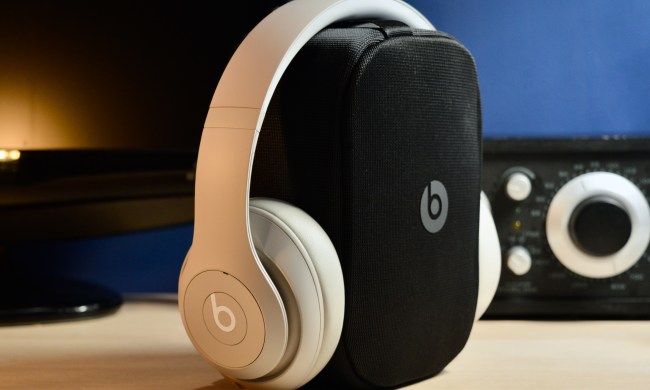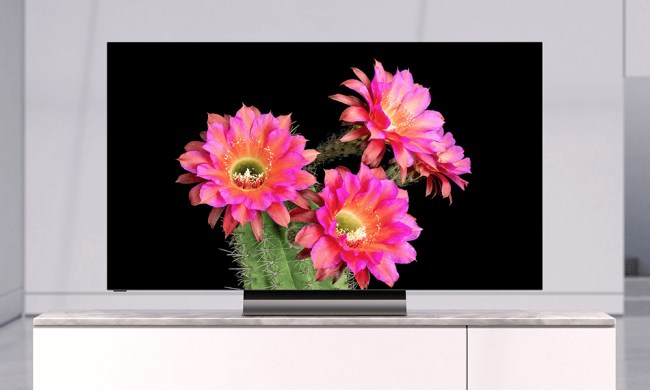
“While Hisense’s T710DW offers some moments of grandeur, its overall performance comes up a bit short with poor screen uniformity, a limited Smart TV platform, and inconsistent handling of standard definition content”
- Rich color contrast
- Good motion resolution
- Convincing 3D
- Affordable
- Excessive blotching in dark scenes
- Some edge flicker on brighter sources
- Active shutter 3D causes eye strain
- Lackluster interface and setup menu
With the relatively recent ascent of South Korean titans Samsung and LG, competition within the LCD TV market has never been fiercer. But Chinese manufacturer Hisense is hoping there’s still room for one more chair at the table. Having conquered its home market as the top brand, Hisense has set its eyes on the US consumer. Its latest offering, the 55-inch T710DW (T710) is stockpiled with a formidable arsenal of features, including 3D, a Smart TV interface, DLNA media sharing, 1080p resolution, and a 120Hz native refresh rate. And at $1100, it’s priced well below similar offerings from competitors. But the question remains: Is Hisense ready for primetime? We sat down with the T710 recently to see if it’s a worthy competitor in its segment. Here’s what we found.
Out of the box
As we pulled the 55-inch display from its packaging, we were greeted by a slim, edge-lit panel measuring 1.6-inches deep and framed by a ½-inch bezel. The TV’s 50 lb. weight was more cumbersome than we’d expected, but nothing grossly out of step with its colleagues.

Covering the front face’s gloss black exterior was the same translucent Plexiglas shield we’ve seen on dozens of similar mid-tier models. In fact, there weren’t a lot of exterior design points we haven’t seen before, save the Hisense logo and accompanying blue LED. With that said, the T710 presents a sleek aesthetic, with a no-nonsense simplicity.
Note to buyers: Hisense tucks part of the TV’s base and some 3D glasses in small recesses in the top-most piece of foam packing material. The pieces are easy to miss, and it would be natural to assume they went unpacked, especially since de-boxing instructions don’t mention their location. Be sure to completely remove all pieces of packing material before attempting to set up the TV.
Features and design
Though the T710 is a budget-priced TV, it’s still Hisense’s premiere model, and, as such, is packed with a wide array of features common for its class. Perusing the T710’s back revealed a recessed bay with an ample selection of inputs including two HDMI, two USB, a VGA input with analog audio input for PC connection, and an Ethernet port. Directly above and to the right was a congruently recessed side bay offering two more HDMI inputs, separate Component and Composite inputs, a Coaxial cable input, a digital coaxial audio output (odd, when optical is far more popular), and an analog headphone out.
The T710’s Smart TV platform is pretty sparse, especially for a TV that floats above the $1000 line.
The T710’s glossy white remote hosts a succinct collection of buttons across its matte black top panel, leaving plenty of space between keys for a relatively ergonomic experience. Along with the normal collection of control keys, the remote includes hot buttons for its Vudu and Netflix apps, as well as a convenient selection of quick-keys for easy access to input sources, picture and sound presets, and the Smart TV interface. While not a full-fledged complaint, we will say that Hisense’s decision to place the battery compartment at the front of the remote, and – oddly – a support sticker upside down towards the opposite end successfully fooled us into picking the device up backwards more times than we care to admit.
Onboard control of the T710 is accomplished via a small row of invisible touch-capacitive keys on the front left panel which illuminate with contact. The only clue the controls exist once the TV has completed its boot cycle is a small, white power symbol painted on the right side. It’s actually a pretty sleek design point, once you’ve located it.
What you won’t find on the T710 is a load of performance-enhancing features like frame interpolation, local dimming, or other digital wizardry common to most of the top brands. While we can never be sure just how much processing is going on behind the scenes on any given TV, the cupboard seemed surprisingly bare as we navigated through the T710’s available picture settings. Still, our first order of business is usually to deactivate a majority of said “enhancements” anyway, so we weren’t particularly disappointed with the omission of most of them.
3D
The T710 uses active shutter 3D technology, which we’ve never been a fan of. The technology requires powered 3D glasses that must be charged and paired with the TV, and cost around $35 (or way, way more) for each additional pair. Aside from the cost and inconvenience of the glasses, active shuttering is known for creating a flicker effect that, among other issues, can make your eyes tire relatively quickly. We’ll dig deeper into this set’s 3D performance shortly.
Smart interface
The T710’s Smart TV platform is pretty sparse, especially for a TV that floats above the $1000 line. Perhaps our favorite feature was its use of an active PIP window, which displayed programming while we accessed and navigated the Smart TV options.
Foreshadowed by the meager selection of app hotkeys on the remote, the T710’s app selection is slim, offering only Vudu, Netflix and YouTube for video streaming. Pandora is the lone music app, and completes the selection of apps that you’ve likely heard of. Aside from those basic selections, the TV includes some ancient games like Chinese checkers and Connect Four, and a browser called Opera. A tour through the sluggish app store provided nothing we’d note as download-worthy.
Aside from its basic apps, the Smart hub also provides icons to peruse media from a USB drive or over a network via DLNA, allowing you to access those videos from your trip to Muncie, IN, or any other media you’ve “acquired” on your home computer.
Setup
Unlike a growing number of today’s Smart TV’s, the T710 lacks much in the way of setup assistance, save an auto search for available OTA channels. Settings such as time zone and network connection must be sought out and set manually.
We had inconsistent results with the T710’s built-in Wi-Fi adapter. In our offices, we had no problem pulling in signals from access points on our floor as well as those above and below. However, in a home testing environment, the TV never picked up our access point, nor did it sense those around us. This could be chalked up to location-specific challenges, but we didn’t have enough time to take the TV to multiple locations.

As for the picture, plenty of adjustment was necessary to get things looking right from the TV’s factory settings. The T710 offers four pre-defined picture presets and just one customizable preset. Alteration of any of the four fixed presets automatically becomes an adjustment of the custom slot, giving users only one customizable option. Out of the box, the T710 was set to Eco, which had ridiculously bright edges, creating an intense flickering of light borders around images. A two point adjustment to the sharpness setting from the Theater preset seemed to go a long way toward correcting the issue, so we continued implementing our adjustments from there.
As mentioned previously, the T710 has very few advanced picture options, and even the basic settings are slim to the degree of omitting Tint control – that’s a first for us. While the meager options made adjustment fairly straightforward, incremental changes often had drastic effects on the picture, making it difficult to find the sweet spot. After a longer-than-usual amount of tinkering on multiple mediums, we got the picture pretty well dialed in. A complete list of our preferred settings is available at the bottom of this review.
Performance
The T710 did a nice job with color contrast, so viewing our trusty Planet Earth Blu-Ray discs on its 55-inch screen presented something of a grand spectacle. A cliff-top scene of a snow leopard’s lair provided a thick spectrum of colors dug from the minerals of the rock, showing deep reds and golds with flecks of aqua and pink among vivid spots of green moss. Vast mountain chains seemed to sprawl to infinity, towering above deep blue lakes. But occasionally, shots taken from helicopter fly-bys revealed the edge flicker we’d noticed earlier, creating a minor strobe effect on rocky surfaces that tempered our experience.
Contrary to the picture settings, the audio menu is stocked with options for adjustment…
Fast moving images were generally well rendered by the T710, with the exception of panning on close-up images, which presented some judder. Other than that, the native 120Hz refresh rate was ample for even the most chaotic scenes without relying on motion enhancement or frame interpolation which create the loathsome “soap-opera effect”.
But when we turned to the deep black of space with some of our favorite sci-fi movies, we found something even more troubling than aliens. Though the display provided a reasonable sense of shadow detail on even our darkest test mediums, it ran into trouble when everything faded to black. Any edge-lit panel without local dimming will inherently have light flares where the LEDs sit, so we weren’t surprised to find some distracting bright spots in the right corners of the screen. But at full black, we were assaulted by a camouflage pattern of milky white images, covering a vast portion of the screen. In fact, the light flare in the top center was obtrusive enough to be seen even in low daylight.
The T710 is also ruthlessly unforgiving with low-quality video signals. Standard definition TV signals (likely delivered at abysmally low bit-rates) looked especially poor, with big, blocky patters marking the image. Imagine taking a low-quality YouTube video, then blowing it up to fit a 55-inch screen and that’s more or less what it looked like. If all you watch is high definition programming, you’ll probably be plenty satisfied with this TV’s picture; but if you watch a fair amount of standard definition content through cable or satellite, you’ll likely be disappointed with what you see.
3D
The T710’s 3D capability was pretty convincing. Though the picture didn’t jump out at us while watching native 3D content, the display provided a pleasant level of depth, allowing us to be submerged in the action. We noted some flatness to some of the imagery, but were generally satisfied with the view. 2D to 3D conversion was also fairly impressive, bringing an expanse to regular programming. However, as expected, the active shutter glasses got to us after about 45 minutes or so, placing the strain of over-focus on our eyes. While it wasn’t exactly painful, we wondered how often we’d actually bother to fire up the 3D feature.
Audio
The T710’s sound was acceptable, especially considering its super-slim frame. Contrary to the picture settings, the audio menu is stocked with options for adjustment, including a “subwoofer” setting, and a 5-point equalizer. The low register was expectantly a bit lacking, but sound was generally clear, with little sharpness in the high range. Unfortunately, the TV lacks any kind of loudness compression, which made for some wide swings in volume from channel to channel and source to source.
Conclusion
While Hisense’s T710DW offers some moments of grandeur, its overall performance comes up a bit short. Poor screen uniformity, a limited Smart TV platform, and inconsistent handling of standard definition content have us looking up the ladder toward some of the T710’s more stalwart competitors. That said, there are some good things happening with this TV – Blu-ray discs in particular looked great – and we wouldn’t be surprised to see future iterations from Hisense making some waves, provided the company can shore up some of these issues while keeping the price down.
To be sure, this TV offers some good screen real estate for the money, but for now, we have to recommend adding the Toshiba 55L7200U or the Samsung UN55ES6500 to your short list of feature-packed, budget-friendly TV options. Keep your eye on Hisense, though, because we expect it will continue its efforts to push the edge of the value envelope and ultimately achieve its goal of becoming a major player in the US TV market.
Highs
- Rich color contrast
- Good motion resolution
- Convincing 3D
- Affordable
Lows
- Excessive blotching in dark scenes
- Some edge flicker on brighter sources
- Active shutter 3D causes eye strain
- Lackluster interface and setup menu
|
Digital Trends Picture Settings |
|
The following settings were arrived at through a process of manual adjustment and further adjusted for preference. As indicated in our How we test televisions article, processing such as noise reduction and dynamic contrast are disabled for picture and testing purposes. They may or may not be re-engaged based on subjective preferences gained from observation during real-world performance scenarios. Though we arrived at these settings with a specific TV size, these settings can be used for any of the sizes in this TV series with consistent results. |
|
Preferred Settings Picture Mode – Custom Brightness – 47 Contrast – 46 Sharpness – 7 Color – 48 Advanced Video Color Temperature – Warm Noise Reduction – Medium Adaptive Contrast – Off |









